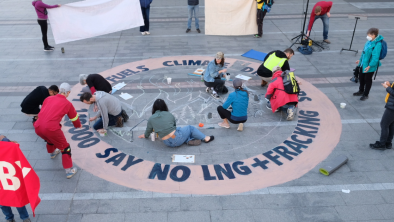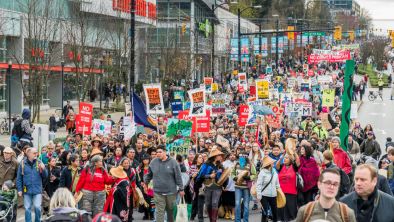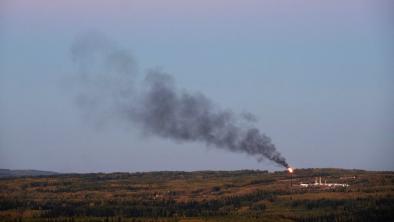Site C hydroelectric project: a northern river of controversy runs through it
Business Vancouver

The approval of BC Hydro’s plan to build a third dam on the Peace River has been welcomed by businesses and builders, but the north will also have to deal with its environmental and infrastructure repercussions
The provincial government’s landmark mid-December decision to end three decades of debate and proceed with BC Hydro’s $8.8 billion Site C dam will do more than divide the Peace River: it has also widened a division through the northeast B.C. communities that will be most affected by the project.
“This is an incredibly stupid decision,” said Grand Chief Stewart Phillip, president of the Union of BC Indian Chiefs, speaking for a group of eight First Nations in northeastern B.C.
“This is the right decision for all British Columbians,” said Jack Davidson, president of BC Road Builders and Heavy Construction Association,which expects its northern members to share in the eight-year construction project.
The Peace Valley Landowner Association has filed an application for a BC Supreme Court judicial review to stop the dam, and the B.C.-based Wilderness Committee is adamantly opposed.
But for many northern businesses stung by Malaysia-based Petronas’ postponement in December of the final investment decision on its multibillion-dollar liquefied natural gas (LNG) plant in the north – and worried that plunging oil prices could imperil other resource projects – Site C is welcome news.
BC Hydro, which plans to begin construction on the project in June, estimates that Site C will generate approximately 10,000 direct jobs and 23,000 indirect jobs and contribute $3.2 billion to British Columbia’s gross domestic product.
“We will be busy,” said Jamie Lewis, manager of Fort St. John’s Quality Inn Northern Grand Hotel, which is already running at an enviable 74% occupancy rate.
Like many hotels in the area, the Northern Grand often books multiple rooms for weeks to workers in the natural gas industry. Lewis expects that Site C, located just seven kilometres from downtown Fort St. John, will generate similar traffic.
The north’s development industry was already gearing up for Site C prior to the December announcement.
According to Fort St. John Mayor Lori Ackerman, the city posted $145.9 million in building permits as of November 2014, up 11% from the same period a year earlier. Residential building permits alone are up 35% over the same period, and at least 100 new hotel rooms are being built.
Construction, she said, is in record territory for the city of 26,000.
Across the Peace River Regional District, total building permits through the first 10 months of 2014 were up 4% to $255.7 million compared with a year earlier.
“A lot of buildings were already going ahead,” said Mitch Collins, a Century 21 owner-broker realtor in Fort St. John, “but [the Site C approval] will speed things up.”
The scale of current projects includes industrial land, commercial buildings, rental housing and the city’s largest mixed-use development. Led by Vancouver developer Gerry Olma, the North Point development will include housing, big-box retail and other commercial real estate in a 220-acre parcel within the city limits. Olma is now selling land at $600,000 per acre, with residential duplex lots going for $150,000 each.Ron Rodgers, partner in NorthEast BC Realty, who had hurried back to his Fort St. John office to watch Premier Christy Clark’s announcement of the Site C approval, was delighted.
“It’s an early Christmas present,” he said.
Rodgers said the announcement “was not a surprise; most of us expected it.”
And that anticipation is reflected in real estate values, he said.
Rodgers had just sold a 4.5-acre gravel-packed industrial lot, with no services, for $989,000, or about twice what it would have fetched a year ago, an indicator of the area’s industrial land shortage.
“BC Hydro bought most of it up long ago,” he said.
Both Rodgers and Collins expect an increase in residential construction, because Fort St. John has about a 1% rental vacancy rate, and house prices are rising.
Despite the heady investments, Ackerman said Site C has been “hugely divisive” in the community and conceded she is divided herself.
“I can take it or leave it,” Ackerman said, noting that the city is pushing BC Hydro and the province to ensure Fort St. John is compensated for any negative impacts of the giant project.
BC Hydro plans to build “one big camp” near the dam site for up to 4,000 construction workers, but Ackerman said that when these employees need medical services, such as lab work or X-rays, they will use the already understaffed regional hospital in Fort St. John.
“There will be pressure on our health services, our police, our schools,” she said. “Our roads certainly aren’t designed to handle heavy equipment traffic. We need hard infrastructure.”
Rodgers believes most people in Fort St. John and the Peace region favour Site C.
“But you don’t hear from the silent majority,” he said.
Treaty 8 First Nations, which represents the five northeastern native groups of Doig River First Nation, McLeod Lake Indian Band, Prophet River First Nation and West Moberly First Nation, disagrees.
Treaty 8 has already launched a court action against the Site C approval and said it will also fight LNG expansion in the area.
BC Hydro CEO Jessica McDonald has stated that “sustained efforts” are being made to train and employ First Nation members on the Site C project. Northern B.C. aboriginal unemployment is 15% – more than twice as high as the overall northeast rate – and spikes as high as 50% for some Treaty 8 communities, such as Doig River.
Grand Chief Phillip is not impressed.
“This is not about jobs,” he said. “This is about a violation of Treaty 8 lands.”
Phillip believes “highly skilled transients” will take most of the Site C jobs. And he believes Treaty 8 will win its injunction against the dam.
“It will be stopped,” he said. “No doubt about it.”
That’s also the opinion of Joe Foy, national campaign director for the Wilderness Committee, who said his organization is against Site C because it will flood farmland and disrupt fish and other wildlife.
“The fight has just started,” Foy said, citing mounting litigation and what he claims is widespread opposition. “It is stoppable.”
But the environmental response is more muted from Mark Shrimpton, professor of ecosystem science and management at Prince George’s University of Northern British Columbia (UNBC). Shrimpton has studied the impact of B.C. dams on fish stocks for 18 years.
“Some species of fish do better, some do worse after a reservoir is established,” Shrimpton said. “It will take decades to understand what the real effect of Site C will be.”
Meanwhile, Site C will be making a huge impact on the northeast B.C. economy, for everyone from realtors and landlords to construction workers and truck drivers.
“Site C will create jobs and provide economic benefits to many generations, and it is so important for British Columbia to capitalize on this unique opportunity,” Davidson said.
Perhaps the most succinct voice on the Site C division came from Julian Brown, 25, a member of the Lake Babian Nation in northern B.C. and a political science student at UNBC.
“We have to look at the environmental aspects,” Brown said, “but we also have to look at job creation and economic opportunity. It is deciding which path to take.” •


